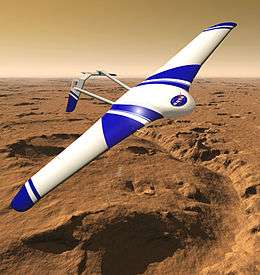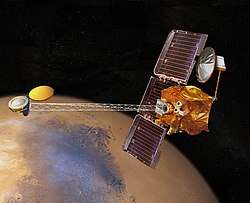Aerial Regional-scale Environmental Survey
The Aerial Regional-scale Environmental Survey (ARES) was a proposal by NASA's Langley Research Center to build a powered aircraft that would fly on Mars.[1][2][3] The ARES team sought to be selected and funded as a NASA Mars Scout Mission for a 2011[4] or 2013 launch window. However, the MAVEN mission was chosen instead.[5] ARES was chosen as one of four finalists in that program.[6]
 ARES aircraft | |
| Mission type | Mars atmospheric probe |
|---|---|
| Operator | NASA |
| Website | marsairplane |
| Mission duration | 1 hour at Mars |
ARES would have traveled to Mars compactly folded into a protective aeroshell; upon entry in the thin atmosphere, the capsule would have deployed a parachute to decelerate, followed by ARES release at altitude.
Among other things, the aircraft would have investigated the atmosphere and weak magnetic field.[7]
Design
ARES would transit to Mars via a cruise stage and enter the Martian atmosphere in a traditional aeroshell with heat shield.[8] At the right altitude it would unfold itself into its flight configuration.[9] Propulsion would likely have come from a bipropellant rocket engine, which was a focus over other types of propulsion during its development,[10] but propulsion remained undetermined. The two main criteria used to evaluate the propulsion system were flight range and implementation risk. Possible propulsion technologies were electrical motors, internal combustion and rocket systems.[4] The aircraft was intended to fly for about one hour.
See also
References
- P.I: Joel S. Levine (November 20, 2009). "Aerial Regional-scale Environmental Survey". Archived from the original on 28 March 2010. Retrieved 2010-03-25.
- Lewis Page (24 November 2009). "NASA plans robot rocket aeroplane to fly above Mars". Space. The Register. Archived from the original on 23 March 2010. Retrieved 2010-03-25.
- Stuart Fox (November 24, 2009). "NASA Robotic Rocket Plane To Survey Martian Surface". Popular Science. Archived from the original on 14 April 2010. Retrieved 2010-03-25.
- Christopher A. Kuhl (March 2009), "Design of a Mars Airplane Propulsion System for the Aerial Regional-Scale Environmental Survey (ARES) Mission Concept" (PDF), Mars Mission Concept, p. 10, retrieved 2010-03-26
- Grey Hautaluoma (Dec 21, 2007). "NASA Delays Mars Scout Mission to 2013". NASA. Archived from the original on 24 May 2011. Retrieved 2011-05-25.
- Levine, J; Blaney, D.L.; Connemey, J.E.P.; Greeley, Ronald; Head Iii, James; Hoffman, John; Jakosky, Bruce; Mckay, Christopher; Sotin, Chrsitophe (2003-09-15). Science from a Mars Airplane: The Aerial Regional-scale Environmental Survey (ARES) of Mars. doi:10.2514/6.2003-6576. ISBN 9781624100949.
- "ARES - Ensuring Reliability". NASA - Langley Research Center. January 14, 2010. Archived from the original on 2010-03-29. Retrieved 2010-03-25.
- Kuhl, Christopher (2008-07-21). "Design of a Mars Airplane Propulsion System for the Aerial Regional-Scale Environmental Survey (ARES) Mission Concept". 44th AIAA/ASME/SAE/ASEE Joint Propulsion Conference & Exhibit. doi:10.2514/6.2008-5246. hdl:2060/20080030375. ISBN 9781600869921.
External links
| Wikimedia Commons has media related to ARES (Mars Scout Program). |

.jpg)
.jpg)